Glechoma, Ground Ivy
Alehoof; Hedera terrestris, Corona Terra
 Herbarius latinus, Petri, 1485
Herbarius latinus, Petri, 1485 |
 Ortus Sanitatis, Meydenbach, 1491
Ortus Sanitatis, Meydenbach, 1491 |
Botanical name:
Glechoma hederacea (syn. Hedera terrestris)
Salmon listed 4 kinds:
1. Common Ground Ivy (Alehoof)
2. Lesser Ground Ivy
3. Mountain Ground Ivy
4. Stone Ground Ivy
The related G. longituba is used in TCM as one form of Jin Qian Cao., and is likewise used for Urinary Stones.
Parts used:
Herb
Temperature & Taste:
Cool, dry. Bitter
Classifications:
3K. EXPECTORANT
Uses:
1. Clears Heat and Damp, Promotes Urine:
-opens Obstructions of the Kidneys and Bladder; Dysuria, Strangury
-Jaundice
-Stones of the Kidneys (int. and in baths and fomentation)
2. Clears Wind and Damp, Benefits the Kidney and Bones:
–Lower Back Pain and weakness associated with Kidney weakness.
-Arthritis, Arthralgia, Rheumatism, Rheumatoid Arthritis, Sciatica, ‘Gout of the hands, knees, or feet’;
–‘boiled in Mutton broth it helps weak and aching backs’ (Gerard)
3. Clears Heat, Resists Poison, Reduces Swelling:
-clears Venom and Poison, including the Plague, Spotted Fevers
-Applied topically and taken internally for Scabs, Itches, Scabies, Erysipelas, spreading Ulcers and Cancers, Swollen Abscesses, Scrofula, Sores, Malignant Lesions and Tumors.
-‘Running Ulcers’ (Cancer), Fistulas
-juice or fresh herb is taken internally for various Cancers.
-Dysentery and Influenza (TCM)
4. Moves the Blood, Promotes Healing:
-internal Bruising, Trauma, Wounds and Fractures.
-expels the Afterbirth.
-Ulcers including Lung Ulcers
5. Clears Phlegm and Heat, Stops Coughs:
-Coughs, Asthma, Bronchitis, Consumption (West, TCM)
-useful in Chronic Bronchitis and chronic Cough with excess Phlegm;
-some preferred it before all other vegetable medicines in the cure of Consumption.
6. Externally:
-ointment for all Burns and Scalds.
-juice has been applied to Fistulas, Spreading Ulcers, Tumors and Cancers
-juice is applied with Honey for Sores and Ulcers, including poor healing Ulcers and Wounds.
-Eye drops for sore, red, inflamed Eyes; also opacity and films of the eyes.
-juice was used for Ulcers of the Mouth, Throat and Genitals.
-Poor hearing, Deafness and Tinnitus, being applied topically (either the steam or juice dropped in)
-Applied fresh to Abscesses and Boils.
-juice or powdered leaves has been credited with curing chronic, obstinate Headaches when used as a snuff
-given in enemas for Colic pains
Dose:
Decoction: 5–15 grams (up to 30 grams for Stones)
Tincture (1:5): 2–5 mls, three times daily.
Juice: 1–3 or 4 oz.
Substitute:
The Chinese herb Lysmachia Jin Qian Cao is used synonymously with the local Chinese Ground Ivy, G. longituba. The main indications for both these herbs in TCM are for Stones. Lysmachia is better for Gall Stones, while Glechoma is best for Urinary Stones. Lysmachia Jin Qian Cao can be used as a substitute, especially when used for Stones and urinary disorders.
Main Combinations:
1. Cough, Bronchitis, Consumption:
i. Ground Ivy with Licorice
ii. Ground Ivy with Plantain
iii. Ground Ivy with Juniper berry
iv. Ground Ivy with Plantain, Comfrey, Licorice
v. Ground Ivy with Coltsfoot, Licorice (Pectoral Infusion from Pharmacopoeia medici practici universalis, Bruxelles, 1817)
vi. Ground Ivy with Maidenhair, Speedwell, Hyssop (equal parts) (Pharmacopoeia Gallica, 1818)
vii. Ground Ivy with Speedwell, Coltsfoot, Licorice, Bittersweet (Pharmacopoeia Rossica, 1803)
viii. Ground Ivy with Pearl Barley, Licorice, Coltsfoot, Speedwell, Red Poppy flower, Mullein flower, Aniseed, Figs (Pharmacopoeia regni Poloniae, 1817)
2. Chronic Cough, Bronchitis, Asthma, Consumption as well as Backache, Diabetes and Arthritis, Ground Ivy with Licorice (as in Gill’s Tea)
3. Asthma, Ground Ivy with Horehound, Arum, Orris, Gum ammoniac
4. Chronic Lung diseases, Ground Ivy with Elecampane, Comfrey, Horehound, Ginger
5. Scarlet Fever, Ground Ivy with Sage, Centaury and Vervain
6. Breast Cancer, Ground Ivy and Wintergreen, boiled in Wine (‘Highly Commended’) (Platerus Golden Practice of Physick, Plater, 1664)
7. Fistulas, Running Ulcers and Cancers, Ground Ivy juice is mixed with Honey and Verdigris
8. As a wash for Sores and Ulcers of the Mouth or Genitals, add Burnt Alum and Honey to a strong decoction of Ground Ivy and use as a wash.
Cautions:
Avoid overdose
Main Preparations used:
Distilled Water, Conserve, Syrup of the Juice, Compound Syrup and the Juice
1. Conserve of Ground Ivy:
Dose: 1 scruple–1 dram
i. fresh Ground Ivy in flower (1 part), White Sugar (2 parts); beat together, then heat in a water-bath until the sugar is melted. (Pharmacopee Usuelle, Louvain, 1821)
ii. Powder of Ground Ivy (½ oz.), Distilled Water of Ground Ivy (sufficient), White Sugar powder (1 oz.). Mix.
2. Syrup of Ground Ivy:
Dose: 1–2 oz.
i. Fresh Ground Ivy (half pound), Boiling Water (3 pounds). Infuse 12 hours, strain and add twice its weight of White Sugar and form a Syrup. (Pharmacopoeia Gallica, 1818)
ii. Depurated Juice of Ground Ivy, Syrup (equal parts), heat to make a syrup. (Pharmacopoeia Sardoa, 1773)
iii. fresh Ground Ivy, beat and express the juice, coagulate it with gentle heat, then to 5 parts of this add 9 parts of Sugar and form a Syrup. (Pharmacopee Usuelle, Louvain, 1821)
3. Extract of Ground Ivy:
i. Ground Ivy (1 pound), Spring Water (6 pounds). Digest for 4 hours, then boil. Express, evaporate to an extract. (Pharmacopoeia Sardoa, 1773)
-
Extra Info
- Research
–The phytochemistry, pharmacology and traditional medicinal use of Glechomae Herba – a systematic review.
